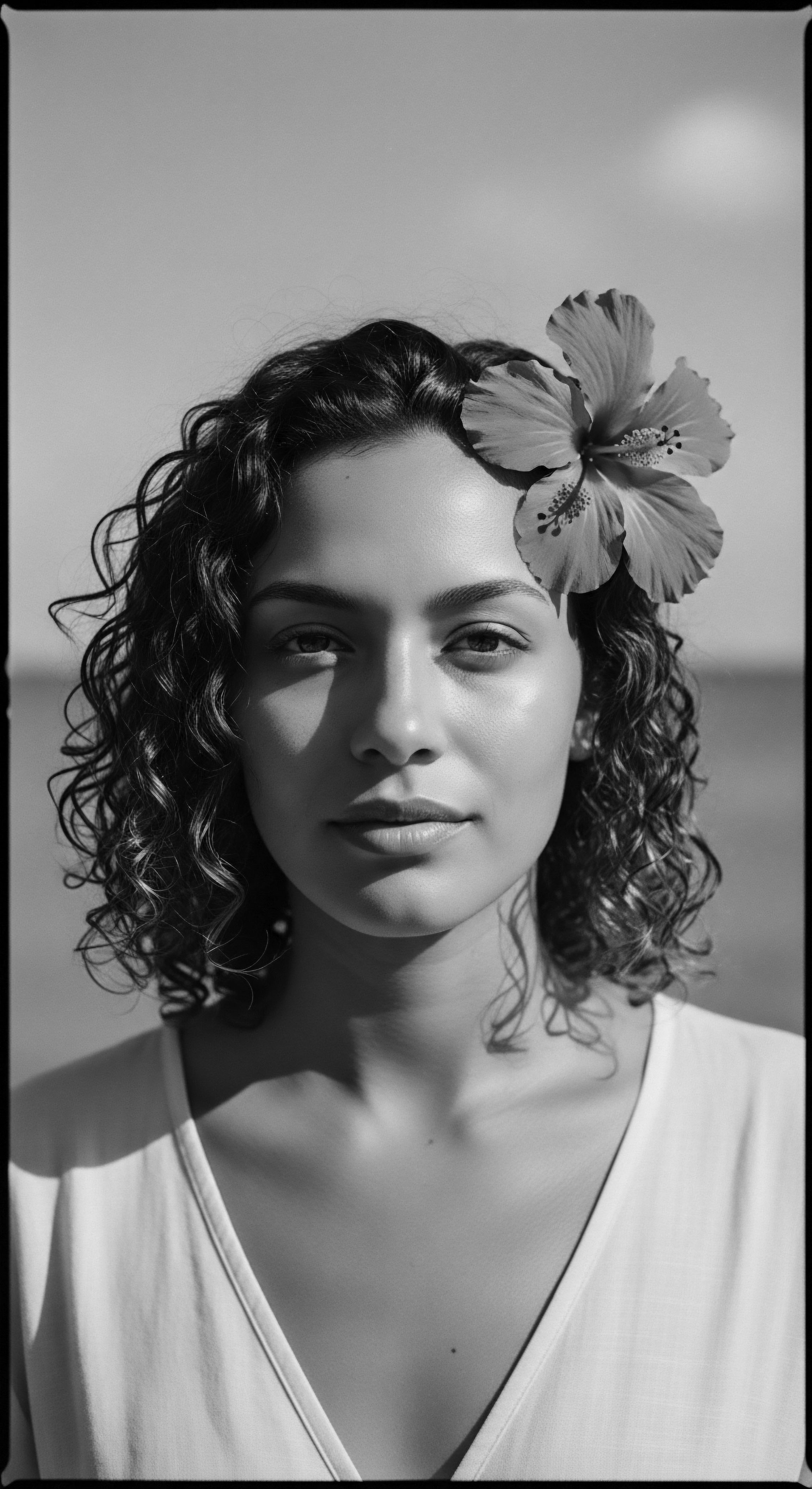
Roots
To journey into the heart of textured hair vitality is to seek ancestral echoes , a lineage stretching back through time, woven into the very fabric of our being. It is an exploration not of fleeting trends or surface appearances, but of the deep, often unspoken wisdom held within each coil and curl. We stand at a threshold, looking back not with longing, but with reverence, asking how the subtle shifts in our forebears’ sustenance—the very sustenance that fed their bodies and spirits—sculpted the resilience and character of the hair that became a crown, a symbol, a heritage. This inquiry invites us to consider the earth, the harvests, the waters, and the ancestral hands that prepared the meals, understanding that the strength and shimmer we seek today bear the imprint of ancient plates.

The Earliest Foraging Plates
Consider, for a moment, the foundational diets of humanity’s origins, particularly across the African continent where the genesis of textured hair is found. These were diets rich in diversity, dictated by the bounty of the seasons and the specific ecosystems inhabited. Foraging societies consumed a spectrum of wild fruits, leafy greens, tubers, roots, and lean proteins from hunted game or gathered insects. Such a diet, inherently varied and devoid of processed elements, provided a comprehensive array of vitamins, minerals, and essential fatty acids.
Micronutrient density was the norm, not a pursuit. The hair, as a rapid-growing tissue, is profoundly responsive to the nutritional landscape of the body. A consistent, high-quality intake of iron from red meat or dark leafy greens, for instance, supported strong follicular function, guarding against loss. Similarly, the abundant vitamin C from wild berries facilitated collagen synthesis , a structural protein essential for the hair shaft’s integrity and elasticity, allowing for resilience.

A Study in Primal Nutrition and Hair Structure
The very structure of textured hair—its unique helical shape, its varied diameter along the shaft, its propensity for dryness—is a testament to evolutionary adaptation. While genetics are the primary architects of this morphology, the cellular machinery that produces each strand relies on a steady stream of specific nutrients. One could theorize that the consistent intake of water-soluble vitamins (B vitamins particularly), found in whole, unprocessed foods, supported the metabolic pathways crucial for keratin formation, the protein that constructs hair.
A diet rich in natural fats, such as those from nuts, seeds, and certain animal sources, provided the lipids necessary for scalp health and the production of natural sebum, which coats and protects the hair. This was not a dietary supplement regimen; it was simply the rhythm of daily life, feeding the body as a whole, with hair vitality a natural outward manifestation of internal balance.
Ancestral sustenance, brimming with inherent diversity, provided the foundational nutrients that sculpted the very resilience and character of textured hair across generations.

Shifting Cultivation and Hair Health
The gradual transition from purely nomadic foraging to settled agricultural practices marked a profound shift in human diet, carrying with it implications for hair vitality. Early agricultural societies, while offering greater food security, often experienced a narrowing of dietary diversity. Reliance on a few staple crops, such as grains or root vegetables, could lead to deficiencies if not balanced with other food groups. A diet heavily reliant on maize, for instance, without adequate protein or niacin sources, could potentially impact the health of skin and hair, reflecting in its lustre and strength.
The shift to more refined grains, even in ancient contexts, meant a loss of crucial B vitamins and minerals contained in the bran and germ. This subtle reduction in a broad spectrum of nutrients, while not immediately catastrophic, could have cumulatively impacted the optimal condition of hair over many generations.

The Legacy of Agricultural Staples on Strands
- Millet ❉ A drought-resistant grain, consumed across parts of Africa and Asia, provides a good source of protein, fiber, and B vitamins, contributing to hair strength.
- Sorghum ❉ Another ancient grain, often a staple in drier regions, supplied essential minerals like iron, supporting blood health and nutrient delivery to follicles.
- Yams and Tubers ❉ Common in many ancestral diets, these provided complex carbohydrates for energy and various micronutrients, aiding overall cellular function including hair growth.

Ritual
The link between what was consumed and how hair flourished extends beyond mere biological function; it delves into the living, breathing rituals of care, where diet and external application were often inextricably bound. The very act of nourishment became a part of a larger, communal dialogue with one’s self and one’s heritage. The wisdom of these rituals, often passed down through generations, implicitly understood the connection between internal vitality and external radiance, long before modern science articulated the complexities of nutrient absorption.

Ancestral Feasts and Hair Fortification
Consider the traditional communal feasts in various African and diasporic cultures. These were not simply meals; they were communal acts of sustenance and connection, often featuring nutrient-dense ingredients prepared with ancestral methods. The slow cooking of collard greens, rich in folate and vitamins A and C , allowed for maximum nutrient availability. Stews simmered with bone marrow provided not only protein but also collagen and gelatin , elements known to support connective tissues, including those vital for healthy hair and scalp.
The inclusion of organ meats, often discarded in modern diets, offered a powerhouse of iron, B vitamins, and zinc, all critical cofactors for robust hair growth and pigmentation. This was a holistic approach to wellbeing, where the nourishment of the body was seen as a continuous, deliberate act, and a healthy head of hair was a visible sign of this careful tending.

The Yoruba Diet and Hair Resilience?
For a profound example, one might turn to the traditional dietary practices of the Yoruba people of West Africa. Their cuisine, historically rich in diverse plant-based foods, legumes, and certain animal proteins, demonstrates how a balanced ancestral diet could contribute to hair resilience . Staples like yams, cassava, corn, and a variety of leafy greens (such as spinach, jute mallow, and water leaves) formed the backbone of their diet. These greens, often consumed in large quantities within stews and soups, are exceptionally rich in vitamins A, C, E, and various B vitamins, alongside minerals like iron and zinc.
Furthermore, the incorporation of legumes like black-eyed peas and groundnuts provided ample plant-based protein and biotin, both cornerstones for keratin synthesis and hair growth. The consumption of fish, a source of omega-3 fatty acids, further bolstered scalp health and hair sheen. This continuous, multi-generational exposure to such a nutrient-dense dietary pattern arguably played a significant part in the observable health and vitality of textured hair within Yoruba communities, fostering a legacy of strong, vibrant strands through consistent internal support (Oyewole et al. 2018). The practice of consuming these foods was often tied to communal cooking and sharing, reinforcing the cultural fabric where wellbeing was a shared endeavor.
Communal ancestral feasts, with their slow-cooked, nutrient-dense ingredients, were not just meals; they were silent pacts for whole-body wellness, naturally fortifying hair.

Beyond Sustenance A Dietary Legacy
As populations migrated, often forcibly through the transatlantic slave trade, dietary shifts became stark and brutal. The limited, often meager rations provided during enslavement—primarily cornmeal, salt pork, and molasses—represented a drastic departure from the diverse ancestral diets. This severe nutritional impoverishment had immediate and lasting consequences for hair vitality. Deficiencies in essential vitamins, minerals, and proteins directly impacted hair growth cycles, leading to brittleness, thinning, and loss.
The anecdotal accounts of scalp conditions and poor hair health among enslaved people are tragic testaments to this profound dietary disruption. However, even in these dire circumstances, resilience surfaced. Enslaved individuals, drawing upon remnants of ancestral knowledge, ingeniously supplemented their diets with wild foraging, cultivating hidden gardens, and incorporating traditional culinary wisdom to maximize the limited nutrients available. This adaptive ingenuity, born of extreme duress, became a new facet of hair heritage – a quiet, powerful act of reclaiming vitality against systemic deprivation.
The impact extended into generations following emancipation, where economic hardship and continued systemic oppression often limited access to diverse, nutrient-rich foods. The reliance on cheap, refined carbohydrates and processed fats became more prevalent, a stark contrast to the original ancestral plates. This dietary shift away from whole, unprocessed ingredients began to subtly, yet cumulatively, alter the nutritional foundation for hair health within Black and mixed-race communities, a legacy whose implications we continue to explore and address today.

Relay
The lineage of textured hair, from its genesis in abundant ancient landscapes to its journey through periods of severe dietary disruption, tells a profound story. This story is not merely one of biological response; it is a relay of resilience, a continuous adaptation, and a testament to the enduring power of ancestral wisdom. Our contemporary understanding of textured hair vitality stands on the shoulders of these past dietary shifts, allowing us to connect the scientific present with the cultural past.

Mitochondrial Legacy and Dietary Markers
One might consider the very cellular factories within our bodies—the mitochondria—which generate the energy for hair growth and protein synthesis. The efficiency of these tiny powerhouses is directly tied to nutrient availability. Ancestral diets, rich in a spectrum of antioxidants from diverse plant sources and healthy fats, supported optimal mitochondrial function. When dietary shifts occurred, leading to nutrient deficiencies or an overload of inflammatory foods, the ripple effect could potentially compromise cellular energy production, thus impacting the vigor of follicular activity.
The concept of nutrigenomics , while a modern field, offers a scientific lens through which to view these ancient connections, suggesting that our genes respond to dietary cues. While individual genetic variations are unique, the collective experience of generations exposed to specific dietary patterns could leave epigenetic marks, subtly influencing how our bodies process nutrients vital for hair.
| Dietary Period Hunter-Gatherer (Ancient Africa) |
| Key Characteristics High nutrient density, diverse wild plants and lean protein. |
| Potential Hair Impact (Heritage Link) Optimal hair strength, elasticity, and growth due to rich micronutrient intake. |
| Dietary Period Early Agriculture (Post-Migration) |
| Key Characteristics Increased reliance on staple crops, potential for nutrient narrowing. |
| Potential Hair Impact (Heritage Link) Subtle shifts in hair robustness if dietary balance was not maintained. |
| Dietary Period Transatlantic Slave Trade (Forced Migration) |
| Key Characteristics Severe caloric and nutritional deprivation, minimal diversity. |
| Potential Hair Impact (Heritage Link) Significant hair fragility, loss, and scalp issues due to profound deficiencies. |
| Dietary Period Post-Emancipation (Diaspora) |
| Key Characteristics Economic constraints, limited access, rise of refined foods. |
| Potential Hair Impact (Heritage Link) Continued challenges to hair vitality, seeking traditional remedies to supplement diet. |
| Dietary Period The enduring journey of textured hair mirrors human dietary evolution, a testament to both biological response and cultural resilience. |

Modern Living, Ancestral Echoes
Today, many Black and mixed-race communities face the double-edged sword of a globalized food system. While access to a wider variety of foods is theoretically available, the prevalence of highly processed, nutrient-poor options often overshadows the traditional wisdom of our forebears. This disconnect impacts not only general health but also the vitality of textured hair. The ancestral wisdom, however, persists, often found in the quiet practices of home cooking, the intentional selection of fresh produce, and the resurgence of interest in traditional herbal remedies.

How Can Contemporary Choices Honor Ancestral Hair Wisdom?
- Whole Foods Revival ❉ Prioritizing unprocessed foods, especially a wide spectrum of fruits, vegetables, and legumes, echoing the diversity of ancestral foraging.
- Healthy Fats Reintegration ❉ Incorporating traditional fats like avocado, coconut, or shea butter (both internally and externally) supports scalp health and hair lipid content.
- Mindful Hydration ❉ Understanding water as a fundamental nutrient, consistent with ancestral reverence for life-giving springs, crucial for hair’s moisture.
The re-engagement with these dietary principles is not simply a health trend; it is an act of reclaiming heritage , a conscious choice to nourish the body and hair in ways that honor the ingenuity and resilience of past generations. It represents a deeper alignment with the natural rhythms and wisdom that once sustained our ancestors, recognizing that the strength of a strand is inextricably linked to the stories held within our collective dietary past.
Contemporary dietary choices, when thoughtfully aligned with ancestral wisdom, serve as a potent bridge, actively reclaiming the deep heritage of textured hair vitality.

Reflection
To ponder the ancestral dietary shifts that impacted textured hair vitality is to engage in a profound act of remembrance. Each coil, each curve, holds within it the whispers of harvests long past, the challenges of sustenance, and the boundless ingenuity of those who came before. The vitality we seek for our textured hair today is not a new aspiration, but a continuation of an enduring legacy, a living thread in the ‘Soul of a Strand’ that reaches back through millennia.
It reminds us that hair, in its intricate beauty, is more than just protein; it is a visible archive of our collective journey, a testament to adaptation, and a vibrant symbol of resilience. As we nourish ourselves with intention, we are not simply tending to our physical bodies; we are honoring a profound heritage, ensuring that the wisdom of our ancestors continues to flow, not just through our veins, but through the very essence of our radiant, unbound helices.

References
- Oyewole, A. K. Okeke, E. C. & Ezeagu, I. E. (2018). Nutritional Composition and Health Benefits of Traditional Yoruba Foods. Journal of Applied Sciences and Environmental Management, 22(10), 1639-1644.
- Crawford, S. & Miller, J. C. (2014). The Story of the Black Hair ❉ A Cultural History. Random House.
- Fussell, B. H. (2005). The Story of Corn. North Point Press.
- Pollan, M. (2006). The Omnivore’s Dilemma ❉ A Natural History of Four Meals. Penguin Press.
- Bogin, B. (2001). The Growth of Humanity. Wiley-Liss.
- Teaford, M. F. & Ungar, P. S. (Eds.). (2007). The First Humans ❉ Origin and Early Evolution of the Genus Homo. Springer.
